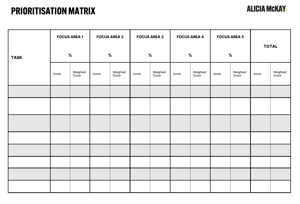What this guide is for
When you have a lot of important things to do, it's easy to get trapped in the details and become overwhelmed.
You get to the end of each day exhausted, after doing countless small tasks - but you've got an overall sense that you should be doing something else, or you didn't do enough.
This is a fast track to burnout and unhappiness.
In this guide, learn the 7 steps you can take to find focus when you're spinning your wheels.

Step 1: Write your list
Chances are, you have a long and invisible list running in your mind. This is extremely unhelpful - because you can’t work with what you can’t see.
Start a to-do list where you write down everything you can think of – big, small, obvious, invisible, the lot.
Consider keeping a running list somewhere accessible over a day or two so that you can add to it as you remember.

Step 2: Reiterate your goals
Your big-picture goals and focus areas should drive your daily reality.
Reiterate what you’re aiming towards right now and consider your key focus areas and objectives.
Bonus tip: keep this somewhere you can see it!

Step 3: Prioritise your goals
Your big-picture goals and focus areas are not created equally.
Consider the relative importance of your objectives by assigning a weighting to them out of a potential 100.
Once you've weighetd them, you can use your goals as evaluation criteria for your tasks and projects!

Step 4: Score your list
Now, you can use the criteria you developed in steps 1-3 to ‘score’ your to-do list.
List each task and project from Step 1 in the left column of the matrix.
List each of your focus areas, and the weighting you assigned them, in the top row of the matrix.
Score each of your tasks for alignment with/ contribution to your key focus area.
Here’s a handy scoring system:
Low alignment/ contribution: 1
Moderate alignment/ contribution: 2
High alignment/ contribution: 3
Then, apply the weighting to tally the total score and pick the winners!
(Look hard? Download your guide to get a prioritisation matrix you can work with!)

Step 5: List your top priorities
Your matrix will have identified your top priorities, based on the highest weighted scores.
List these now, and consider:
- Grouping related items
- Readjusting as required
- Timing, dependencies and deadlines.
Then, identify your top 2 or 3 priorities to work with in more detail.

Step 6: Detail your priorities
It’s time to turn your top priorities into tangible entities you can work with. Spend some time considering:
- The steps and milestones involved.
- How long each step or milestone will take.
- What help or support will you need?
- Who else needs to be involved?
- Dependencies, deadlines and connections to other tasks.
- Risks and things that might go wrong.

Step 7: Make a plan
Now it’s time to consider how you can bring an overall plan with milestones into your calendar.
Allocate sufficient time each day or week to complete your priority in the target timeline, and consider who you need to bring in.
Workbook
Here's a handy downloadable workbook - and an explanatory video - to help you work through the focus process yourself.

